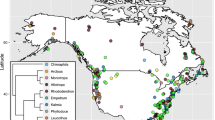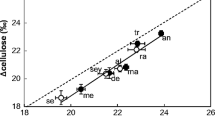Summary
In an earlier paper we provided evidence that carbon isotope discrimination during photosynthesis of terrestrial C3 plants decreases with altitude, and it was found that this was associated with greater carboxylation efficiency at high altitudes. Changing partial pressures of CO2 and O2 and changing temperature are possible explanations, since influences of moisture and light were reduced to a minimum by selective sampling. Here we analyse plants sampled using the same criteria, but from high and low altitudes along latitudinal gradients from the equator to the polar ends of plant distribution. These data should permit separation of the pressure and temperature components (Fig. 1). Only leaves of fully sunlit, non-water-stressed, herbaceous C3 plants are compared. The survey covers pressure differences of 400 mbar (ca. 5000 m) and 78 degrees of latitude (ca 25 K of mean temperature of growth period). When habitats of similar low temperature (i.e. high altitude at low latitude and low altitude at polar latitude) are compared, discrimination increases towards the pole (with decreasing altitude and thus increasing atmospheric pressure). Latitudinally decreasing temperature at almost constant atmospheric pressure (samples from low altitude) is associated with a decrease in discrimination. So, polar low-altitude plants have δ13C values half way between humid tropical lowland and tropical alpine plants. It is unlikely that latitudinal changes of the light regime had an effect, since low and high altitude plants show contrasting latitudinal trends in δ13C although local altitudinal differences in overall light consumption were small. These results suggest that both temperature and atmospheric pressure are responsible for the altitudinal trends in 13C discrimination. Temperature effects may partly be related to increased leaf thickness (within the same leaf type) in cold environments. Theoretical considerations and laboratory experiments suggest that it is the oxygen partial pressure that is responsible for the pressure related change in discrimination. The study also provided results of practical significance for the use of carbon isotope data. Within a community of C3 plants, discrimination in species of similar life form, exposed to similar light, water and ambient CO2 conditions ranges over 4‰, with standard deviations for 10–30 species of ±0.6 to 1.2‰. This natural variation has to be taken into account by using a sufficient sample size and standardization of sampling in any attempt at ecological site characterization using carbon isotope data. Evidence of a pronounced genotypic component of this variation in 13C discrimination in wild C3 plant species is provided. Correlations with dry matter partitioning, mesophyll thickness and nitrogen content are also present.
Similar content being viewed by others
References
Arroyo MK, Medina E, Ziegler H (1990) Distribution and δ13C values of Portulaceae species of the high Andes in Northern Chile. Acta Bot 103:291–295
Bauer H, Thöni W (1988) Photosynthetic light acclimation in fully developed leaves of juvenile and adult life phases of Hedera helix. Physiol Plant 73:31–37
Berry J, Troughton JH, Björkman O (1972) Effect of oxygen concentration during growth on carbon isotope discrimination in C3 and C4 species of Atriplex. Carnegie Institution Year Book 71:158–161, Washington
Bongi G, Hubick KT (1987) On line isotope discrimination of olive leaves (abstract). Suppl Plant Physiol 83:34
Brooks A, Farquhar GD (1985) Effect of temperature on the CO2/O2 specificity of ribulose-1,5-bisphosphate carboxylase/oxygenase and the rate of respiration in the light. Estimates from gas exchange measurements on spinach. Planta 165:397–406
Ehleringer JR, Field CB, Lin ZF, Kuo CY (1986) Leaf carbon isotope and mineral composition in subtropical plants along an irradiance cline. Oecologia 70:520–526
Ehleringer JR, Lin ZF, Field CB, Sun GC, Kuo CY (1987) Leaf carbon isotope ratios of plants from a subtropical monsoon forest. Oecologia 72:109–114
Evans JR, Sharkey TD, Berry JA, Farquhar GD (1986) Carbon isotope discrimination measured concurrently with gas exchange to investigate CO2 diffusion in leaves of higher plants. Aust J Plant Physiol 13:281–292
Farquhar GD, Richards RA (1984) Isotopic composition of plant carbon correlates with water-use efficiency of wheat genotypes. Aust J Plant Physiol 11:539–55
Farquhar GD, Sharkey TD (1982) Stomatal conductance and photosynthesis. Ann Rev Plant Physiol 33:317–345
Farquhar GD, Wong SC (1984) An empirical model of stomatal conductance. Aust J Plant Physiol 11:191–210
Farquhar GD, O'Leary MH, Berry JA (1982) On the relationship between carbon isotope discrimination and the intercellular carbon dioxide concentration in leaves. Aust J Plant Physiol 9:121–137
Farquhar GD, Ehleringer JR, Hubick KT (1989) Carbon isotope discrimination and photosynthesis. Ann Rev Plant Physiol Plant Mol Biol 40:503–537
Francey RJ, Hubick KT (1988) Tree-ring carbon-isotope ratios re-examined. Nature 333:712
Francey RJ, gifford RM, Sharkey TD, Weir B (1985) Physiological influences on carbon isotope discrimination in huon pine (Lagastrobos franklinii). Oecologia 44:241–247
Francey RJ, Robbins FJ, Allison CE, Richards NG (1990) The CSIRO global survey of CO2 stable isotopes. In: Wilson SR, Ayers GP (eds) Baseline Atmospheric Program (Australia) 1988, Dept of Administrative Services, and CSIRO Australia, Melbourne, pp 16–27
Friend AD, Woodward FI, Switsur VR (1989) Field measurements of photosynthesis, stomatalconductance, leaf nitrogen and δ13C along altitudinal gradients in Scotland. Funct Ecol 3:117–122
Halloy SRP (1982) Climatologia y edafologia de alta montana en relacion con la composicion y adaptacion de las comunidades bioticas (con especial referencia a las Cumbres Calchaquies, Tucuman, Argentina). PhD Thesis, Tucuman. Univ. Microfilms Internat., Ann Arbor, no. 8502967
Körner Ch (1988) Does global increase of CO2 alter stomatal density? Flora 181:253–257
Körner Ch (1989) The nutritional status of plants from high altitudes. A worldwide comparison. Oecologia 81:379–391
Körner Ch, Diemer M (1987) In situ photosynthetic responses to light, temperature and carbon dioxide in herbaceous plants from low and high altitude. Funct Ecol 1:179–194
Körner Ch, Larcher W (1988) Plant life in coid climates. In: Long PS, Woodward FI (eds) Plants and temperature. Symp Soc Exp Biol 42: 25–57, The Company of Biologists Ltd, Cambridge
Körner Ch, Mayr R (1981) Stomatal behaviour in alpine plant communities between 600 und 2600 metres above sea level. In: Grace J, Ford ED, Jarvis PG (eds) Plants and their atmospheric environment. Blackwell, Oxford, pp 205–218
Körner Ch, Renhardt U (1987) Dry matter partitioning and root length/leaf area ratios in perennial plants with diverse altitudinal distribution. Oecologia 74:411–418
Körner Ch, Bannister P, Mark AF (1986) Altitudinal variation in stomatal conductance, nitrogen content and leaf anatomy in different plant life forms in New J Zealand. Oecologia 69:577–588
Körner Ch, Farquhar GD, Roksandic Z (1988) A global survey of carbon isotope discrimination in plants from high altitude. Oecologia 74:623–632
Körner Ch, Neumayer M, Pelaez Menendez-Rield S, Smeets-Scheel A (1989) Functional morphology of mountain plants. Flora 182:353–383
Lancaster J (1990) Carbon-13 fractionation in carbon dioxide emitted diurnally from soils and vegetation at ten sites on the North-American continent. PhD Thesis, University of San Diego. Univ. Microfilms Internat., Ann Arbor, no. 9024008
Leavitt SW, Long A (1985) Stable-carbon isotopic composition of maple sap and foliage. Plant Physiol 78:427–429
Martin B, Nienhuis J, King G, Schäfer A (1989) Restriction fragment length polymorphisms associated with water use efficiency in tomato. Science 243:1725–1727
Masle J, Farquhar GD (1988) Effects of soil strength on the relation of water-use efficiency and growth to carbon isotope discrimination in wheat seedlings. Plant Physiol 86:32–38
Masle J, Farquhar GD, Gifford RM (1989) Growth and carbon economy of wheat seedlings as affected by soil resistance to penetration and ambient partial pressure of CO2. Aust J Plant Physiol 17:465–487
Medina E, Minchin P (1980) Stratification of δ13C values in Amazonian rain forests. Oecologia 45:377–378
Medina E, Montes G, Cuevas E, Roksandic Z (1986) Profiles of CO2 concentration and δ13C values in tropical rain forests of the upper Rio Negro basin, Venezuela. J Trop Ecol 2:207–217
Mooney H, Troughton JH, Berry JA (1974) Arid climates and photosynthetic systems. Carnegie Inst Yearb 73:793–805
Mooney HA, Berry J, Björkman O, Ehleringer J (1982) Comparative photosynthetic characteristics of coastal and desert plants of California. Bol Soc Bot Mexico 42:19–33
Morecroft MD, Woodward FI (1990) Experimental investigation on the environmental determination of δ13C at different altitudes. J Exp Bot 41:1303–1308
O'Leary MH (1988) Carbon isotopes in photosynthesis. Fractionation techniques may reveal new aspects of carbon dynamics in plants. BioScience 38:328–336
Osmond CB (1983) Interaction between irradiance, nitrogen nutrition, and water stress in the sun-shade response of Solanum dulcamara. Oecologia 57:316–321
Sage RF, Sharkey TD, Seemann JR (1989) Acclimation of photosynthesis to elevated CO2 in five C3 species. Plant Physiol 89:590–596
Schleser GH, Jayasekera R (1985) δ13C-variations of leaves in forests as an indication of reassimilated CO2 from the soil. Oecologia 65:536–542
Sharkey TD (1988) Estimating the rate of photorespiration in leaves. Physiol Plant 73:147–152
Stuiver M, Braziunas TF (1987) Tree cellulose 13C/12C isotope ratios and climatic change. Nature 328:58–60
Virgona JM, Hubick KT, Rawson HM, Farquhar GD, Downes RW (1990) Genotypic variation in transpiration efficiency, carbon-isotope discrimination and carbon allocation during early growth in sunflower. Aust J Plant Physiol 17:207–214
Vitousek PM, Field CB, Matson PA (1990) Variation in foliar δ13C in Hawaiian Metrosideros polymorpha: A case of internal resistance? Oecologia 84:362–370
Vogel JC (1978) Recycling of carbon in a forest environment. Oecol Plant 13:89–94
Vogel JC, Grootes PM, Mook WG (1970) Isotopic fractionation between gaseous and dissolved carbon dioxide. Z Physik 230:225–238
vonCaemmerer S, Evans JR (1991) The determination of average partial pressure of CO2 in chloroplasts from leaves of several C3 plants. Aust J Plant Physiol 18:287–305
Walters MB, Field CB (1987) Photosynthetic light acclimation in two rainforest Piper species with different ecological amplitudes. Oecologia 72:449–456
Winter K (1981) CO2 and water vapor exchange, malate content and δ3C value in Cicer arietinum grown under two water regimes. Z Pflanzenphysiol 101:421–430
Wong SC, Dunin FX (1987) Photosynthesis and transpiration of trees in a Eucalypt forest stand: CO2, light and humidity responses. Aust J Plant Physiol 14:619–632
Wong SC, Cowan IR, Farquhar GD (1985) Leaf conductance in relation to rate of CO2 assimilation. I Influence of nitrogen nutrition, phosphorus nutrition, photon flux density and ambient partial pressure of CO2 during ontogeny. Plant Physiol 78:821–825
Woodward FI (1986) Ecophysiological studies of the shrub Vaccinium myrtillus taken from a wide altitudinal range. Oecologia 70:580–586
Zimmerman JK, Ehleringer JR (1990) Carbon isotope ratios are correlated with irradiance levels in the Panamanian orchid Catasetum viridiflavum. Oecologia 83:247–249
Author information
Authors and Affiliations
Rights and permissions
About this article
Cite this article
Körner, C., Farquhar, G.D. & Wong, S.C. Carbon isotope discrimination by plants follows latitudinal and altitudinal trends. Oecologia 88, 30–40 (1991). https://doi.org/10.1007/BF00328400
Received:
Accepted:
Issue Date:
DOI: https://doi.org/10.1007/BF00328400




